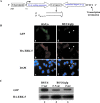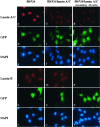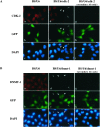A DNA vector-based RNAi technology to suppress gene expression in mammalian cells
- PMID: 11960009
- PMCID: PMC122801
- DOI: 10.1073/pnas.082117599
A DNA vector-based RNAi technology to suppress gene expression in mammalian cells
Abstract
Double-stranded RNA-mediated interference (RNAi) has recently emerged as a powerful reverse genetic tool to silence gene expression in multiple organisms including plants, Caenorhabditis elegans, and Drosophila. The discovery that synthetic double-stranded, 21-nt small interfering RNA triggers gene-specific silencing in mammalian cells has further expanded the utility of RNAi into mammalian systems. Here we report a technology that allows synthesis of small interfering RNAs from DNA templates in vivo to efficiently inhibit endogenous gene expression. Significantly, we were able to use this approach to demonstrate, in multiple cell lines, robust inhibition of several endogenous genes of diverse functions. These findings highlight the general utility of this DNA vector-based RNAi technology in suppressing gene expression in mammalian cells.
Figures



Similar articles
-
U6 promoter-driven siRNAs with four uridine 3' overhangs efficiently suppress targeted gene expression in mammalian cells.Nat Biotechnol. 2002 May;20(5):497-500. doi: 10.1038/nbt0502-497. Nat Biotechnol. 2002. PMID: 11981564
-
Analysis of gene function in somatic mammalian cells using small interfering RNAs.Methods. 2002 Feb;26(2):199-213. doi: 10.1016/S1046-2023(02)00023-3. Methods. 2002. PMID: 12054897
-
Construction of simple and efficient DNA vector-based short hairpin RNA expression systems for specific gene silencing in mammalian cells.Methods Mol Biol. 2007;408:223-41. doi: 10.1007/978-1-59745-547-3_13. Methods Mol Biol. 2007. PMID: 18314586
-
Development of resistance to RNAi in mammalian cells.Ann N Y Acad Sci. 2005 Nov;1058:105-18. doi: 10.1196/annals.1359.019. Ann N Y Acad Sci. 2005. PMID: 16394130 Free PMC article. Review.
-
RNA interference and its current application in mammals.Chin Med J (Engl). 2004 Jul;117(7):1084-91. Chin Med J (Engl). 2004. PMID: 15265387 Review.
Cited by
-
Tfap2a and 2b act downstream of Ptf1a to promote amacrine cell differentiation during retinogenesis.Mol Brain. 2015 May 13;8:28. doi: 10.1186/s13041-015-0118-x. Mol Brain. 2015. PMID: 25966682 Free PMC article.
-
Inhibition of hepatitis B virus expression and replication by RNA interference in HepG2.2.15.World J Gastroenterol. 2006 Oct 7;12(37):6046-9. doi: 10.3748/wjg.v12.i37.6046. World J Gastroenterol. 2006. PMID: 17009407 Free PMC article.
-
RNA interference technologies for understanding and treating neurodegenerative diseases.Neuromolecular Med. 2004;6(1):1-12. doi: 10.1385/NMM:6:1:001. Neuromolecular Med. 2004. PMID: 15781973 Review.
-
Downregulation of IGF-IR expression by RNAi inhibits proliferation and enhances chemosensitization of human colon cancer cells.Int J Colorectal Dis. 2010 Jan;25(1):9-16. doi: 10.1007/s00384-009-0783-2. Epub 2009 Aug 11. Int J Colorectal Dis. 2010. PMID: 19669768
-
Gene silencing in alveolar type II cells using cell-specific promoter in vitro and in vivo.Nucleic Acids Res. 2004 Sep 27;32(17):e134. doi: 10.1093/nar/gnh129. Nucleic Acids Res. 2004. PMID: 15452203 Free PMC article.
References
Publication types
MeSH terms
Substances
Grants and funding
LinkOut - more resources
Full Text Sources
Other Literature Sources
Research Materials

